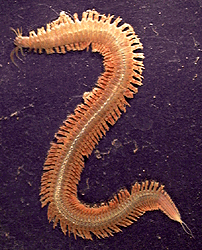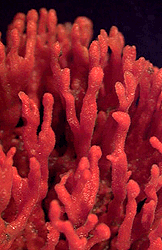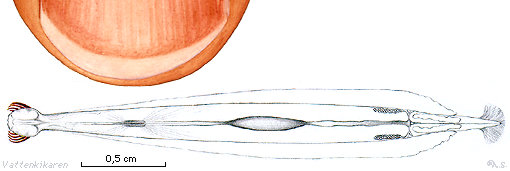Back to: Biology 112 Syllabus
Back to: Biology 112: Evolution and EcologyHome Page
Back to: Kenyon College Biology Department
The organism at right is a pink-mouthed clustered hydroid, Tubularia crocea.
(Image from Cyberhaus Marine Life Pages)
What trends occurred during the evolution of animals, and what do we know about protosomates?
The
images in this section come from a nifty Biology 120 Animal Physiology Exercise at the University of Tennessee
at Martin. Check it out!
Bilateral symmetry:
The significance of this trend is bilateral symmetry provides the basis for coordinated and directed
movements. Environmental gradients (including food sources) could be sensed better by comparing the two sides of
the bilateral body.
Cephalization:
Developing a head region in a general body plan was important for sensing the environment and for directing
movement, particularly toward food sources and away from predators.
Establishment of three germ layers:
(Images from the Univeristy of Tennesse at Martin Biology pages)
Animals can be either diploblastic or triploblastic. An animal is diploblastic if its body develops from only two
fundamental tissue layers; it is triploblastic if its body develops from three fundamental tissue layers. Diploblasty
apparently evolved earlier than did triploblasty. The third germ layer is significant because it gives rise to
muscle tissue, excretory organs, reproductive organs, the hear, and blood vessels. These tissues are, of course,
essential in larger organisms.
Protostomate and Deuterostomate lineages:
The names protostome and deuterostome derive from the differing fate of the initial opening of the primitive
digestive tract (the archenteron) in an embryo. As illustrated in the following picture, in protostomes, this initial
opening develops into the mouth, and an opening that develops later becomes the anus. In deuterostomes, it develops
into the anus, and an opening that develops later becomes the mouth.
(Images from the Univeristy of Tennesse at Martin Biology pages)
Determinate cleavage is characteristic of protostomes . After the initial cell division the fate of the
resulting daughter cells is determined -- these cells can only develop into specific tissues, not the whole organisms.
Indeterminate cleavage is characteristics of deuterostomes . After the initial cell division the fate of
the resulting daughter cells is not determined -- each has the potential to develop into an entire organism.
Sometimes this occurs; resulting individuals are genetically identical (in humans, they are called identical twins).
Protostome
and deuterostome cleavage differs in other ways too:
(Images from the Univeristy of Tennesse at Martin Biology pages)
Coelom
development:
A coelom is a body cavity completely surrounded by mesoderm. The coelom can be used as a hydrostatic skeleton,
i.e., for support. It provides an avenue for release of, for example, gametes and excretory waste. It also provides
a place for internal organ placement.
The coelom can develop via two pathways:
(Image from the Univeristy of Tennesse at Martin Biology pages)
 Development of a complete gut:
Development of a complete gut:
Development of a mouth and an anus permitted more efficient processing of food. Food could be taken
in, stored, digested, and assimilated in separate areas of the gut. Early protostomes, including cnidarians, used
mostly intracellular digestion, i.e., food taken into individual cells. With the complete gut, extracellular digestion
became more important by permitting chunks of food to be ingested and efficiently digested and absorbed. (Image of cnidarian at right from Tree of Life)
Organs and systems:
Development of organs and systems represents specialization and therefore increasing morphological and physiological
efficiency.
 Segmentation:
Segmentation:
A basic element of a body plan is repeated a number of times. The significance of this trend is that each element,
although similar, can be modified for a specific function, nearly independently of other segments. Segmentation
permits flexibility for diverse functional requirements. (Image of brittle star at left from Tree of Life)
 Homeostasis:
Homeostasis:
Homeostasis is the ability of a multicellular organism to maintain a stabile physiological state (e.g.,
body temperature or blood gases). Homeostatic mechanisms tend to increase in the course of evolution, and permitted
animals to live in more diverse environments while maintaining a constant internal environment. The implication
is that organisms gained more control mechanisms for fine-tuning its physiology, but integrative systems (e.g.,
nervous system) became more important. (Image of segmented worm at right from Tree of Life)
See this site for a real nice review of what we've covered above,
and for an introduction to some of the relevant organisms.
What
about phylogenies?
The figure at right, also from the University of Tennessee at Martin Biology 120 course pages, shows one phylogeny of the genetic relationships among animal groups.
 Check
out the Tree of Life site, from
the University of Arizona, which provides most of the know phylogenetic relationships among taxa and organisms,
along with additional information and photos about many of them. Image of ribbon worm at left from their great site.
Check
out the Tree of Life site, from
the University of Arizona, which provides most of the know phylogenetic relationships among taxa and organisms,
along with additional information and photos about many of them. Image of ribbon worm at left from their great site.
 Also check out the UC
Berkeley Museum of Paleontology Web Lift site, for additional information and phylogenies of the primitive
animals.
Also check out the UC
Berkeley Museum of Paleontology Web Lift site, for additional information and phylogenies of the primitive
animals.
Microciona sponge, at right, from the Tree of Life.
Definitions and terms to know:
Evolution of Deuterostostomes
What differentiates a deuterostome from a Protostome?
- different developmental patterns in embryonic and larval stages
- have true coelom
- fate of blastopore is different
- radial and indeterminate cleavage
Patterns of diversity: finding new ways to eat and/or not be eaten:
- Lophophore
- major groups: Phoronids, Brachiopods, Bryozoans, Pterobranchs
- spines and fins (arrow worms, see below)
- internal skeleton (echinoderms)
- pharyngeal gill slits (acorn worms)

Figure 8.1. Diagram of extant arrow worm with human finger drawn for scale (© Aquascope 2000. Tjärnö Marine Biological Laboratory, Strömstad, Sweden). There are currently some 65 species of marine arrow worms (phylum Chaetognatha). Adults are swift, predatory organisms with eyes, tiny teeth and spines. They are stabilized by lateral fins and swim by muscle contractions. Their embryonic development shows them to be part of the same major group as the vertebrates.
What were some key evolutionary innovations in the non-chordate animal phyla?
Phylum Echinodermata
- water vascular system with tube feet
- radial (five part) symmetry
- calcium containing skeletal plates in body wall/skin.
Phylum Hemichordates (acorn worms)
- bilateral wormlike body
- pharyngeal gill slits - in the wall of the pharanyx – (these are also found in all chordates at some point in
their development) – used for feeding, not breathing
- dipleurula larvae - very similar to the echinoderm larvae
What defines the Chordates (Phylum Chordata)?
Phylum Chordata
- pharyngeal slits
- dorsal hollow nerve cord
- notochord, at least during embryonic development
- tail
The origin of vertebrates (Subphylum Vertebrata): Revolutions in complexity
What were the key innovations in the vertebrates that led to increasing sensory capacity?
* vertebrae – a column of vertebrae replaced the notochord as the primary support structure.
* skull
* gills in pharyngeal slits
* closed circulatory system
What were some evolutionary advances in predation:
- size
- jaws
- buoyancy control
- paired appendages (fins, limbs)
Making the transition to land: what challenges must be overcome?
| Evolution of.... | Aquatic forms | Terrestrial forms |
| Structural support | supported by water | skeleton, limbs |
| Oxygen exchange | exchange water across gills | lungs |
| Water balance | plentiful, diffusion | problems of water loss |
| Reproduction | often external | often internal |
Step 1: Lobed finned fishes
- strong, muscular fins, able to move on land for short periods with help of sac like lungs
Step 2: Amphibians (terrestrial in some parts of life cycle, aquatic in others)
- better developed lungs, but skin still functions in gas exchange
- four limbs
- need water for egg development
Step 3: Reptiles (radiation into dry environments)
- the "land egg", an amniotic egg with a shell
- skin impermeable to water (proteinaceous scales)
- uric acid as an excretory product
- stronger limbs
Quiz Materials - study to your hearts content (courtesy of www.gpc.peachnet.edu/~pgore/geology/historical_lab)
What is the oldest vertebrate fossil, according to the University
of California at Berkeley Museum of Paleontology?
(give genus and period) ________________________________
An article in Nature in 1996 described some of the oldest known fish fossils
http://www-geology.ucdavis.edu/~GEL3/Anatolepis.html.
Based on this answer the following:
Note: Amphibians were the first land-dwelling vertebrates. Today, adult amphibians live on land and breathe
air, but
they lay their eggs in the water. Young amphibians live in the water and are fish-like (tadpoles, for example).
What were the major characteristics of amphibians?
Check your lecture notes or textbook to answer these questions.
See also this reference http://museum.gov.ns.ca/fossils/amazing/joggins.htm.
Please note: Complete colonization of land was achieved by the reptiles which could lay eggs on land. Egg-laying,
however, is
not easy to identify in the fossil record. Two characteristics of the skull which can be used to distinguish reptiles
form amphibians are:
1.The reptile skull is high and narrow, whereas the amphibian skull is low and broad
2.The roof of the mouth of the reptile is arched, with small openings. The roof of the mouth of the amphibian
is flat with large openings.